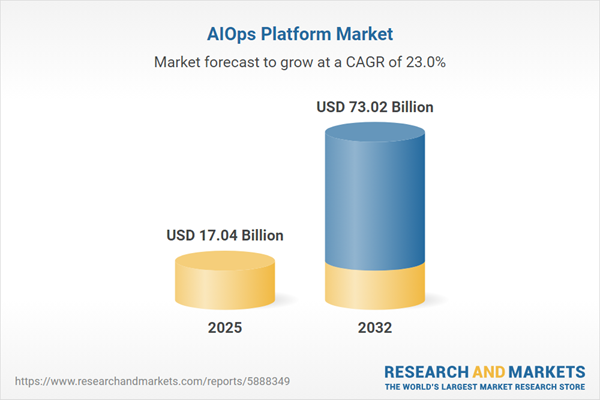Speak directly to the analyst to clarify any post sales queries you may have.
The AIOps platform market is entering a phase of accelerated transformation, driven by enterprise demands for operational agility and resilient IT infrastructure. Senior technology and business leaders are adopting AIOps solutions to manage growing complexity, optimize service delivery, and support robust digital transformation across sectors.
Market Snapshot: AIOps Platform Market Growth and Outlook
The AIOps platform market grew from USD 13.95 billion in 2024 to USD 17.04 billion in 2025. It is expected to continue growing at a CAGR of 22.97%, reaching USD 73.02 billion by 2032. Leading organizations are leveraging these platforms to shift from reactive IT monitoring to proactive, analytics-driven management. This growth trajectory highlights how rapidly enterprises are prioritizing automation and advanced analytics to keep pace with evolving business needs and digital ecosystems.
Scope & Segmentation
- Component: Encompasses platforms offering analytics, automation workflows, and event correlation, as well as services like consulting, implementation, and system integration.
- Organization Size: Addresses both large enterprises with complex multi-cloud environments and small and medium enterprises seeking modular, scalable solutions.
- Application: Covers application performance analysis, infrastructure management, network and security management, and real-time analytics.
- Vertical: Includes banking, financial services & insurance (BFSI), energy & utilities, government & defense, healthcare & life sciences, IT & telecom, media & entertainment, and retail & eCommerce.
- Deployment: Spans cloud-based and on-premise models, offering options around data sovereignty, elasticity, and update cycles.
- Geography: Analyzes major regions—including the Americas, EMEA, and Asia-Pacific—and their respective sub-regions to account for regulatory, economic, and technology readiness differences.
- Technology Providers: Evaluates a broad ecosystem from established industry giants to pure-play software vendors, as well as specialist firms offering innovative features and services.
Key Takeaways for Senior Decision-Makers
- AIOps adoption empowers IT teams to pivot from manual responses toward intelligent, automated workflows, enhancing system stability and business continuity.
- Hybrid and multi-cloud support in AIOps tools enables organizations to manage distributed IT resources more efficiently, building cross-environment visibility and reliability.
- Organizations are increasingly integrating AIOps with DevOps pipelines to embed predictive insights within continuous development, reducing deployment risk and accelerating remediation.
- The emergence of flexible licensing and consumption-based models helps organizations address budget pressures and adapt to shifting business priorities.
- Strategic investments in data quality and aggregation processes enhance AIOps efficacy, supporting the delivery of accurate, actionable insights that underpin operational excellence.
- Regional dynamics, such as stringent regulatory environments or rapid digitalization trends, require tailored AIOps strategies matched to local market maturity and compliance requirements.
Tariff Impact on AIOps Adoption and Supply Chain Dynamics
Anticipated United States tariff adjustments in 2025 are expected to influence procurement costs for hardware components integral to AIOps deployments. Enterprises may need to recalibrate allocated budgets or shift toward cloud-based consumption to contain capital expenditures. Increased costs in professional services—should global travel or supply logistics be impacted—may further drive demand for localized delivery models and diversified vendor ecosystems. Modular, software-centric offerings could help mitigate volatility and support robust service continuity in diverse regulatory landscapes.
Methodology & Data Sources
This report is built on extensive secondary research across industry publications, standards, and regulatory directives, combined with primary interviews with IT leaders and practitioners. Data validation included cross-referencing proprietary datasets, survey responses, and the application of triangulation, SWOT analysis, and technology maturity models to provide structured, actionable insights.
AIOps Platform Market: Why This Report Matters
- Enables executive teams to align operational investments with emerging AI and automation trends, maximizing long-term digital transformation outcomes.
- Delivers actionable recommendations tailored to IT infrastructure leaders facing shifting supply chain, regulatory, and market pressures.
- Equips organizations to benchmark vendor strategies and select solutions best suited to evolving business and compliance needs.
Conclusion
The AIOps platform market is reshaping operational models across sectors by merging automation, data science, and strategic risk management. Senior leaders equipped with these insights can accelerate transformation, strengthen organizational resilience, and enhance IT-driven business value.
Additional Product Information:
- Purchase of this report includes 1 year online access with quarterly updates.
- This report can be updated on request. Please contact our Customer Experience team using the Ask a Question widget on our website.
Table of Contents
3. Executive Summary
4. Market Overview
7. Cumulative Impact of Artificial Intelligence 2025
Companies Mentioned
The companies profiled in this AIOps Platform market report include:- Amazon Web Services, Inc.
- BigPanda, Inc.
- BMC Software, Inc.
- Broadcom Inc.
- Cisco Systems, Inc.
- CloudFabrix Software Inc.
- Cloudwise
- Datadog, Inc.
- Dell Inc.
- Dynatrace, Inc.
- Elasticsearch B.V.
- GAVS Technologies
- Google LLC by Alphabet Inc.
- HCL Technologies Limited
- Hewlett Packard Enterprise Company
- Hexaware Technologies Limited
- Infosys Ltd.
- International Business Machines Corporation
- LogicMonitor Inc.
- LTIMindtree Limited
- MeshIQ
- Microsoft Corporation
- Netreo, Inc.
- New Relic, Inc.
- OKESTRO Co., Ltd.
- OpenText Corporation
- Oracle Corporation
- PagerDuty, Inc.
- Prodapt Solutions Private Limited
- ProphetStor Data Services, Inc.
- ScienceLogic, Inc.
- Selector Software, Inc.
- ServiceNow, Inc.
- Tata Consultancy Services Limited
- Tech Mahindra Limited
- VuNet Systems Private Limited
- Wipro Limited
- Zenoss Inc.
- Zoho Corporation
Table Information
| Report Attribute | Details |
|---|---|
| No. of Pages | 185 |
| Published | November 2025 |
| Forecast Period | 2025 - 2032 |
| Estimated Market Value ( USD | $ 17.04 Billion |
| Forecasted Market Value ( USD | $ 73.02 Billion |
| Compound Annual Growth Rate | 22.9% |
| Regions Covered | Global |
| No. of Companies Mentioned | 40 |









